Exposure to the sun causes skin to darken. This is because of the production of the melanin, a pigment that protects the lower layers of the skin from sun damage. Damaged skin produces more melanin leading to further skin darkening. Staying out of the sun or blocking sun exposure can reverse this and lighten skin back to its natural color.
Structure of the skin
The skin forms the largest organ of the body. It performs many important functions including protecting the body from trauma, regulating body temperature, maintaining electrolyte and water balance, sensing pleasant and painful stimuli and synthesizing Vitamin D.
The skin consists of three layers: Epidermis, dermis and the subcutaneous layer (fat layer). Each layer has its own specific tasks to perform.
Epidermis
This is the tough, relatively thin external layer of skin. The majority of cells present in the epidermis are the keratinocytes, which originate from the cells of the basal layer (deepest layer of the epidermis). New keratinocytes migrate slowly upwards towards the surface of the skin. They are shed gradually, replaced by new cells from below.
Melanocytes are the cells that are present in the basal layer of the epidermis. They produce melanin pigment, which is the major contributor to skin’s colour. However, the primary function of melanin is to filter ultraviolet (UV) radiation from sunlight. UV radiation can damage DNA and which can result in many harmful effects such as skin cancer.
Dermis
The next layer of skin is the dermis. It is a thick layer made of elastic and fibrous tissue, giving the skin its strength and flexibility. The nerve endings, sebaceous glands, sweat glands, blood vessels, and hair follicles are present in the dermis.
Fat/ Subcutaneous layer
A fat layer is present beneath the dermis, and it helps in insulating the body from cold and heat. It also provides protective padding and serves as an area to store energy. Fat cells are the fat present in cells. Fibrous tissue holds these cells together.
What determines skin colour?
Human skin comes in various colours ranging from shades of almost white to dark brown. Melanin, among other factors, influences an individual’s skin colour. It also determines the colour of a person’s eyes and hair.
Intrinsic factors
Genetics determine the levels of melanin. People whose parents are fair will inherit their parents’ fair skin, and people whose parents are dark will similarly inherit their parents’ dark skin. Constitutive pigmentation refers to the level of skin pigmentation inherited at birth.
There are also numerous other factors determined at the time of birth that influences the skin colour, such as the way the body makes hormones and the way these hormones convey information to melanin-producing cells. These genetic factors cannot be altered, and are also known as intrinsic factors.
Extrinsic factors
There are certain extrinsic factors that exist outside the body which may influence the colour of the skin and impart acquired pigmentation. One of the most significant extrinsic factors is exposure to the sun’s UV radiation. The sun produces UVB and UVA rays. Different kinds of UV sun rays cause different effects on skin colour.
Exposure to UVA rays influences the melanin present in the upper layers of the skin. This causes immediate pigmentation. Skin pigmentation that occurs a few days after exposure to the sun is due to the production of new melanin in response to exposure to UVB rays. Other extrinsic factors that influence the colour of skin include damage to DNA and age. The way the body produces melanin changes as an individual age.
Melanin
Two Kinds of Melanin
Melanin is a skin pigment present in skin cells. There exist two kinds of melanin that produce visibly different effects on skin pigmentation.
- Pheomelanin, a yellow-red coloured melanin, is the primary melanin present in people who have fair skin.
- Eumelanin produces pigmentation of a dark brown colour and it is the primary type of melanin present in people who have dark skin. Eumelanin provides better protection from the sun’s UV rays in comparison to pheomelanin. Hence, fair-skinned persons are at higher risk of getting sunburn.

Everyone is different
Genes determine the content of melanin present in the skin. This implies that a person inherits their skin colour from their parents. Specifically, a gene referred to as SLC24A5 has been identified as a major determinant of skin colour.
The more melanin made by a person’s skin, the darker their skin will be. Some individuals make more melanin than others. Every individual has approximately the same number of melanin-producing cells but everybody does not make the same quantity of melanin.
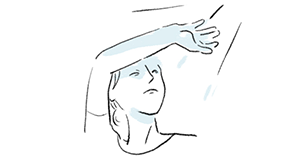 Influenced by outdoors
Influenced by outdoors
The total amount of time spent outdoors and exposed to the sun also influences melanin levels, as the body increases its production of melanin upon sun exposure. A person who works outdoors every day in the sun develops more tanned or darkly pigmented skin over time in comparison to if they would have worked indoors every day.
Why some people have more melanin than others
Melanin has a key role to play in protecting the body from UV rays as it helps to filter the sun’s rays before they can cause damage to skin cells. Sun exposure stimulates the body to make more melanin to protect the skin cells.
A person’s skin colour is closely associated with what part of the world they come from. People who have dark skin originate from places which have higher levels of UV radiation or places that are closer to the equator.
Melanogenesis
Melanin is produced in special cells referred to as melanocytes. Melanogenesis is the process by which melanocytes make the pigment melanin. They are abundantly present in the basal layer of the epidermis and also the underlying dermis.
DNA is damaged upon exposure to UV rays. This triggers growth factors, cytokines and other types of inflammatory factors. It also stimulates melanin synthesis. Granules of melanin produced in melanocytes are transferred to the cells called keratinocytes. Both these cells form a protective layer in the inner epidermis, absorbing UV rays and inhibiting their penetration.
Melanin synthesis starts in the liver, where phenylalanine converts to tyrosine. The enzyme phenylalanine hydroxylase catalyzes this reaction. Melanosomes, which are cell organelles present in melanocyte, produce melanin. L-Tyrosine is oxidized to form L-DOPA and the reaction is catalyzed by the tyrosinase enzyme. Other enzymes which are involved in melanin synthesis are TRP1 (tyrosinase-related protein 1) and TRP2 (tyrosinase-related protein 2). L-DOPA is then oxidized to form DOPAquinone. From here, the pathway to synthesize melanin diverges to produce either pheomelanin or eumelanin. Melanosomes get transferred to the keratinocytes.
Melanin is stored longer in people with dark skin but degrades quickly in people with light skin.
For the determination of skin colour, the type of melanin pigment produced by cells is more important than the number of melanocytes. The quantity and size of melanosomes also help in determining the colour of the skin. Darkly pigmented skin is associated with more prolific, elongated and larger melanosomes.
Factors that add pigmentation to the skin
If the body’s melanocytes produce an excessive amount of melanin, this can cause hyperpigmentation. Some factors that increase melanin production include:
 Sun exposure
Sun exposure
The major cause of the skin darkening is sun exposure as sunlight triggers the production of melanin. Melanin acts as the skin’s own natural sunscreen as it protects it from the sun’s harmful UV rays, resulting in tanned skin. However, excessive sun exposure can result in a disruption of this process and can lead to hyperpigmentation or dark skin. Moreover, once dark spots have developed, exposure to the sun may aggravate them by making melasma, age spots, post-inflammatory hyperpigmentation or even darker freckles.
Hormonal changes
Hormonal changes can cause a specific type of hyperpigmentation, called chloasma or melasma. Commonly present among females, the female hormones progesterone and estrogen on sun exposure cause the stimulation of melanin production. Melasma is also referred to as “the mask of pregnancy” as it primarily affects pregnant females on the face.
 Age
Age
Age is a factor in darkening of the skin. As a person get older, their skin’s ability to repair itself is reduced; hence, the damage across many years becomes visible. Exposure to UV rays is one of the most common causes of dark skin.
Hormonal changes that occur during various phases of life such as pregnancy or menopause may also result in an over-stimulation of melanocytes, causing them to produce more melanin. Age spots are small, dark, flat patches usually found on the skin of areas that get more sun exposure such as the face, forearms, back of hands, shoulders and forehead. As a person ages, the increased activity of the melanin-producing cells causes age spots. Genetics also plays a key role in the development of hyperpigmented age spots.
Post-inflammatory hyperpigmentation
Hyperpigmentation of the skin occurs after an injury or inflammation of the skin such as a burn, cut, exposure to chemicals, eczema, psoriasis or acne. It results when the area of skin remains discoloured and darkened after the injury or inflammation has healed.
Medicines
Hyperpigmentation may occur as a side effect of some medicines. Examples of these are drugs to control seizures, antibiotics, hormonal medicines, antimalarials and chemotherapeutic drugs.
Illnesses
Hyperpigmentation may also occur as a symptom of certain medical problems including certain metabolic disorders, vitamin deficiencies and certain gastrointestinal and autoimmune diseases.
Occupations
Certain jobs may result in hyperpigmentation as they may increase the risk of exposure to chemicals or sun. People who are at an increased risk of this include tar or pitch workers, gardeners, and individuals who work in bakeries or perfumeries.
Tattoos
Residual hyperpigmentation may result from photo-contact dermatitis caused by tattooing or using henna dyes.
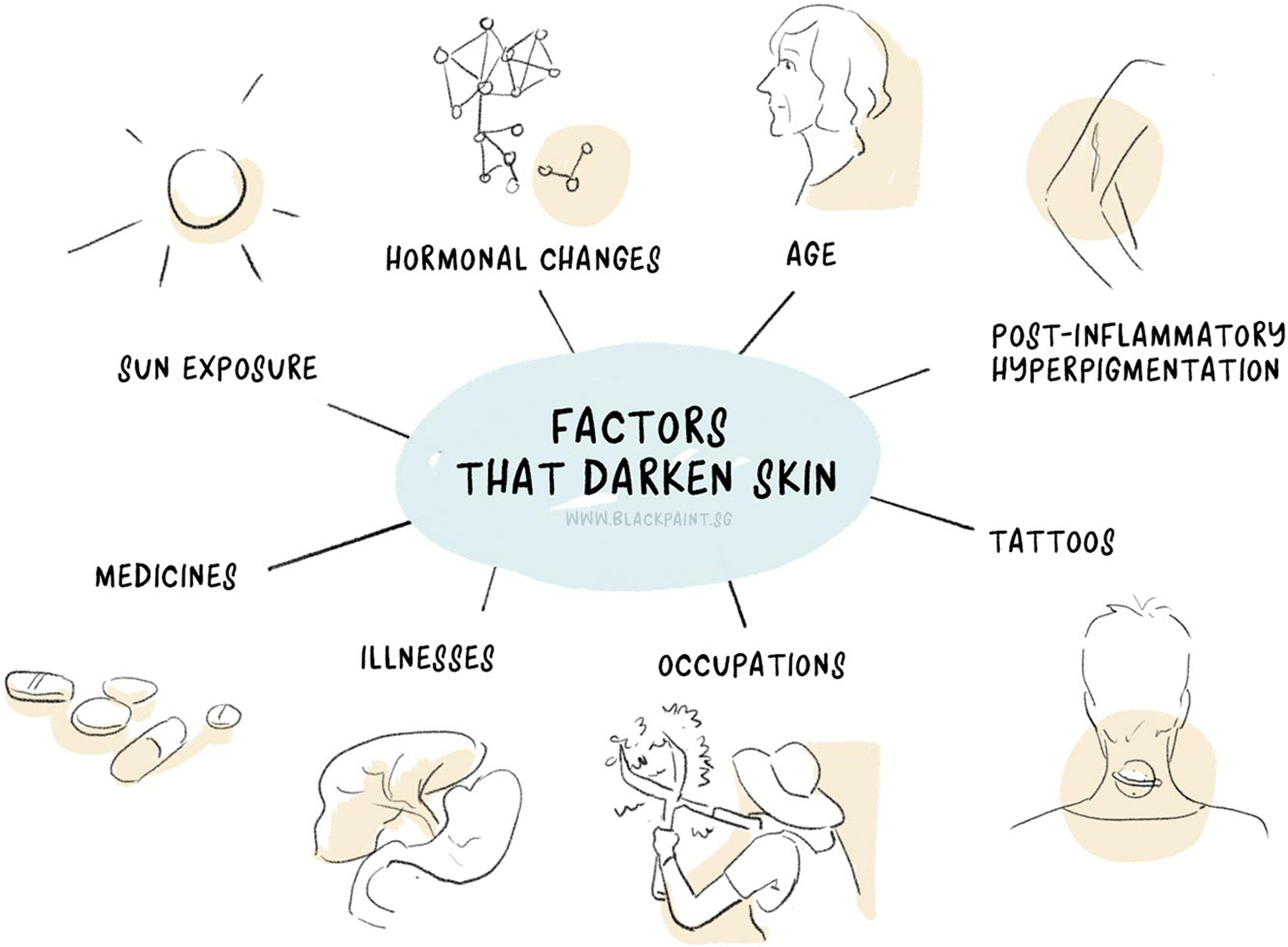
Mechanisms by which skin becomes darker
Melanin protects the body from harmful UV rays by either absorbing or deflecting them. Excessive UV radiation results in sunburn and DNA damage and the body protect itself by producing more melanin, causing skin darkening and tanning. Production of a tan due to UV exposure occurs through two different mechanisms. Firstly, UVA rays produce oxidative stress that oxidizes the present melanin and results in a quick darkening of the skin. UVA rays may also result in a redistribution of melanin, but does not influence the total quantity of melanin. Skin darkening from exposure to UVA rays does not result in a significantly raised production of melanin and does not protect against sunburn.
Exposure to UVB rays during the second mechanism increases melanogenesis. This is the body’s reaction to direct DNA damage from exposure to UV rays. Melanogenesis results in delayed tanning and is generally visible two to three days post exposure to UV rays. A tan produced here may last for several weeks or months, compared to the tan produced by oxidation of present melanin. This tan also protects the skin against exposure to UV rays and sunburn and is not simply cosmetic. It can typically provide an SPF of 3, which implies that your tanned skin can allow up to three times the exposure to UV rays in comparison to pale skin.
Besides melanin, certain other pigments such as carotene and haemoglobin also help in determining the colour of the skin.
Haemoglobin
This is a red pigment that is present in the blood. It results in the skin being redder in areas where blood vessels run close to the surface; for instance, the lips.
Carotene
Carotene is the orange-red pigment found in vegetables and fruits. According to a study published in the American Journal of Public Health, eating more vegetables and fruits can change the skin tone to a healthier golden glow.
Is turning darker a permanent or temporary thing?
Exposure to the sun’s UV radiation results in changes in skin colour. Too much sun exposure in the short term may result in erythema or sunburn. Exposure to UV rays for long durations stimulates the production of melanin resulting in the tanning of the skin over a period of a few days. Other skin changes that are induced by exposure to UV rays include freckles, moles, thickening of the outer skin layer, and premature skin ageing characterized by increased dryness, wrinkles and reduced skin elasticity.

Immediate changes in skin pigmentation that are visible within five to ten minutes after exposure to sun and which last for several days are caused by exposure to UVA rays. They occur as the melanin that is stored in the keratinocytes gets redistributed. Delayed pigmentation that occurs a few days after sun exposure and lasts for several weeks or months is caused by exposure to UVB rays. This occurs due to increased melanin production by the melanocytes, especially eumelanin.
The tanning that occurs immediately after exposure to the sun is temporary; however, prolonged exposure to the sun’s rays may produce deeper pigmentation and almost permanent darkening of the skin. This may require a longer time and more treatment sessions for the skin to lighten back to its original colour.
Is it possible for the skin colour to change entirely?
All of us are born with a skin colour that is lighter than the skin colour that we have as adults. This happens partly because gradually over time our exposure to sunlight darkens our skin.
While it is possible for the skin to return to its lighter, (almost) original shade, it is highly unlikely for it to turn into a completely different colour. This means that with the correct treatment and protection, you may be able to return your skin colour to approximately its original shade, but you will not be able to change brown coloured Asian skin to pale coloured Caucasian skin.
Similarities and differences between sunblock and skin whitening products
A sunblock or sunscreen is a topical product that upon application to the skin works by either absorbing or reflecting or blocking the UV rays of the sun; hence, protecting your skin from turning darker. In a way, they prevent the synthesis of melanin that is triggered by exposure to UV rays.
A skin whitening treatment works by reducing the pigment melanin in your skin by several possible mechanisms as discussed earlier. They may reduce the already present melanin or prevent synthesis of new melanin in melanocytes.
The similarity between sunblocks/ sunscreens and skin whitening products is that the aim of both of them is to make your skin fairer or prevent it from turning dark. Sunscreens do so by preventing the synthesis of melanin so that your skin does not turn dark, whereas skin whitening products do so by reducing the amount of melanin already present and also by preventing the synthesis of new melanin in melanocytes. Some skin whitening products also increase the turnover of skin cells resulting in newer cells replacing the older layer of cells quickly. The new cells have less melanin and therefore your skin looks fairer than before.
Prevention of skin darkening through sun protection
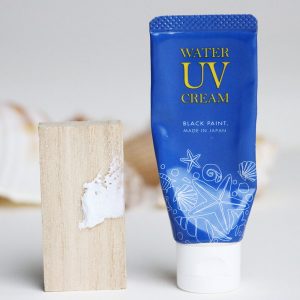 When you may want to add some kind of sun protection in your daily beauty regimen. You may be wondering whether to apply sunscreen or sunblock. Many people believe that these two sun protection products are one and the same thing. Several differences exist between sunblock and sunscreen and as a knowledgeable consumer, you need to learn the difference. This holds particular importance for people who have sensitive skin or whose skin is prone to developing discolouration and acne. Understanding the difference between sunscreen and sunblock may help you in making well-informed decisions when purchasing sun protection products for your skin.
When you may want to add some kind of sun protection in your daily beauty regimen. You may be wondering whether to apply sunscreen or sunblock. Many people believe that these two sun protection products are one and the same thing. Several differences exist between sunblock and sunscreen and as a knowledgeable consumer, you need to learn the difference. This holds particular importance for people who have sensitive skin or whose skin is prone to developing discolouration and acne. Understanding the difference between sunscreen and sunblock may help you in making well-informed decisions when purchasing sun protection products for your skin.
What is a sunblock?
A sunblock is a topical product that upon application to the skin reflects the sun’s UV rays, blocking them from reaching the skin by forming a reflective layer on its surface. It uses the physics of light reflection as the protective mechanism, and is therefore called ‘physical’ sunblock.
The ingredients responsible for UV reflection are zinc oxide or titanium dioxide. Reducing UV lights reaching the skin reduces the production of the dark pigment, Melanin, in the skin. Over time, less melanin means lighter skin.
Is sunblock a whitening sunblock?
Sunblock uses physics to reflect UV radiation. By itself, it does not whiten the skin, which is a chemical process. “Whitening” sunblock, or whitening sunscreen in the market has additional chemicals or bleaching agents to achieve active whitening effects.
If your skin is prone to acne, make sure to purchase sunblock labelled “non-comedonal”. Sunblock can block pores and worsen acne.

What is a sunscreen?
Sunscreen is a topical product which, upon application to the skin, protects it from the sun’s UV radiation by absorbing it. It does not physically block the UV rays like sunblocks do. Instead, its chemical compound, upon sun exposure creates a chemical reaction converting UV light energy to heat which is dissipated from the skin’s surface. This formula consists of Benzophenones which absorb UVA rays and salicyclates and cinnamates which absorb UVB rays. In this way, a sunscreen prevents UV radiation from penetrating deep into the skin’s surface thereby reducing melanin production.
Does sunscreen lighten skin?
Sunscreen deactivates UV radiation and therefore protects the skin from its damage. As a result of reduced production of melanin – the darkening pigment, the skin tone becomes lighter over time. However, it doesn’t whiten the skin like whitening or bleaching agents which are chemicals that reduce the amount of melanin already present in the skin.
These ingredients are often listed as octyl salicylate, octyl methoxycinnamate or oxybenzone. It is also called a chemical sunscreen. Sunscreens are less visible than sunblocks on the skin. However, a major disadvantage is that its ingredients disintegrate after several hours of sunlight exposure, which means that the sunscreen needs to be reapplied.
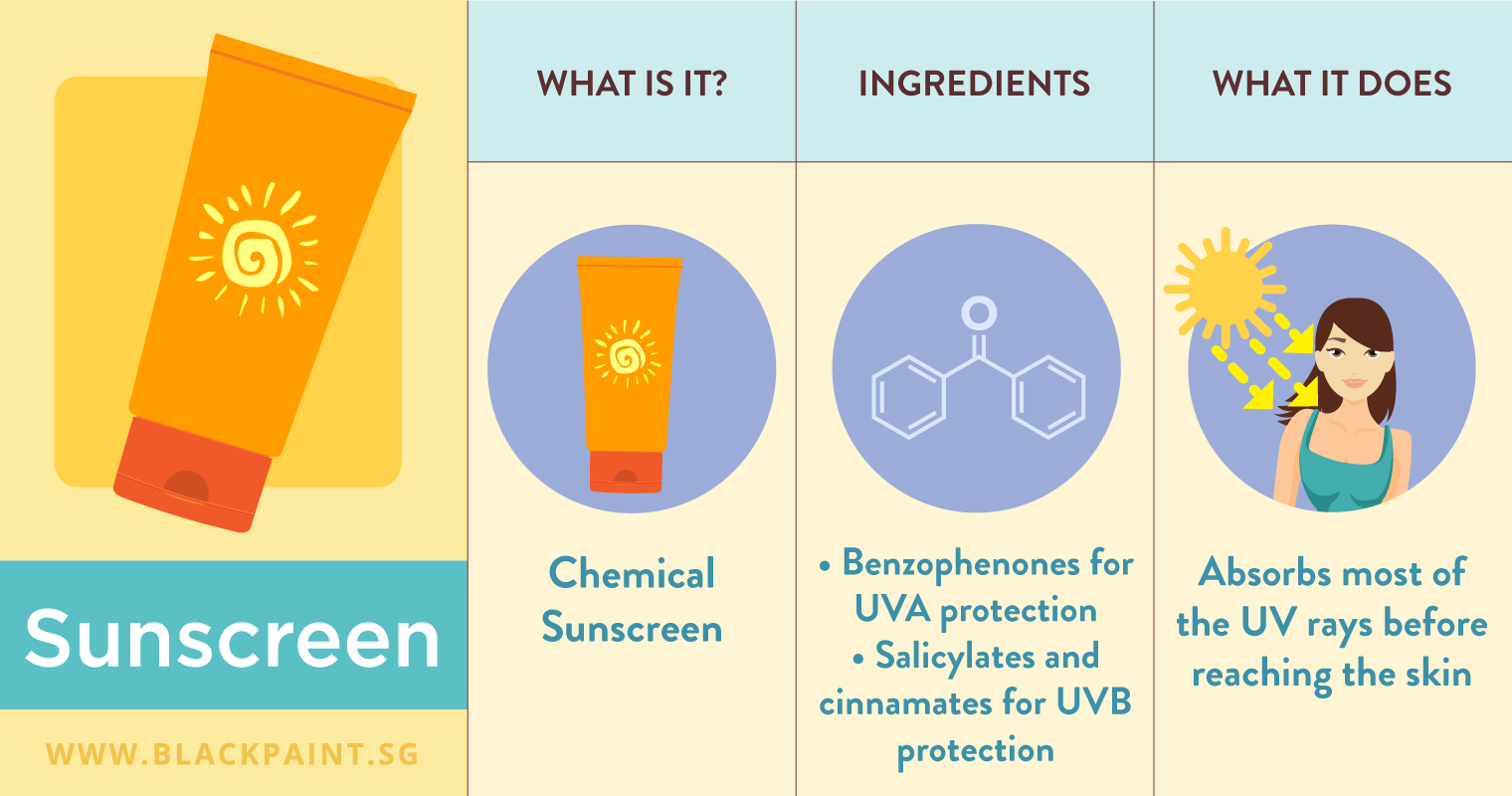
Mechanism of action of sunblock vs sunscreen
Sunscreen or sunblock are products that are applied topically and that work by either absorbing, reflecting or blocking the sun’s UV rays, protecting your skin against sunburn. Regular use of sunblock and sunscreen may also temporarily prevent the development of moles, sagging skin and wrinkles.
UVA rays are able to penetrate the deeper skin layers and result in the immediate effect of tanning. UVA stimulates melanin that is already present in the upper epidermis, tanning the skin quickly and disappearing just as quick. UVA rays also penetrate into the deeper layers of the skin (dermis) affecting the blood vessels and connective tissues. Due to this, your skin begins to lose its elasticity and develops wrinkles. Hence, excessive exposure to UVA rays results in premature aging. Moreover, according to recent studies, it may promote the occurrence of skin cancers. It is hypothesized that oxidative stress is increased in the skin cells by UVA exposure.
UVB rays are not able to penetrate beyond the epidermis. They are responsible for burning and delayed tanning. UVB stimulates new melanin production resulting in a darker colour of skin within a few days of sun exposure. This tan usually lasts a long time in comparison to a tan caused by exposure to UVA rays. UVB rays also stimulate the production of a thicker epidermal layer. Hence, UVB causes both the thickening and darkening of the skin.
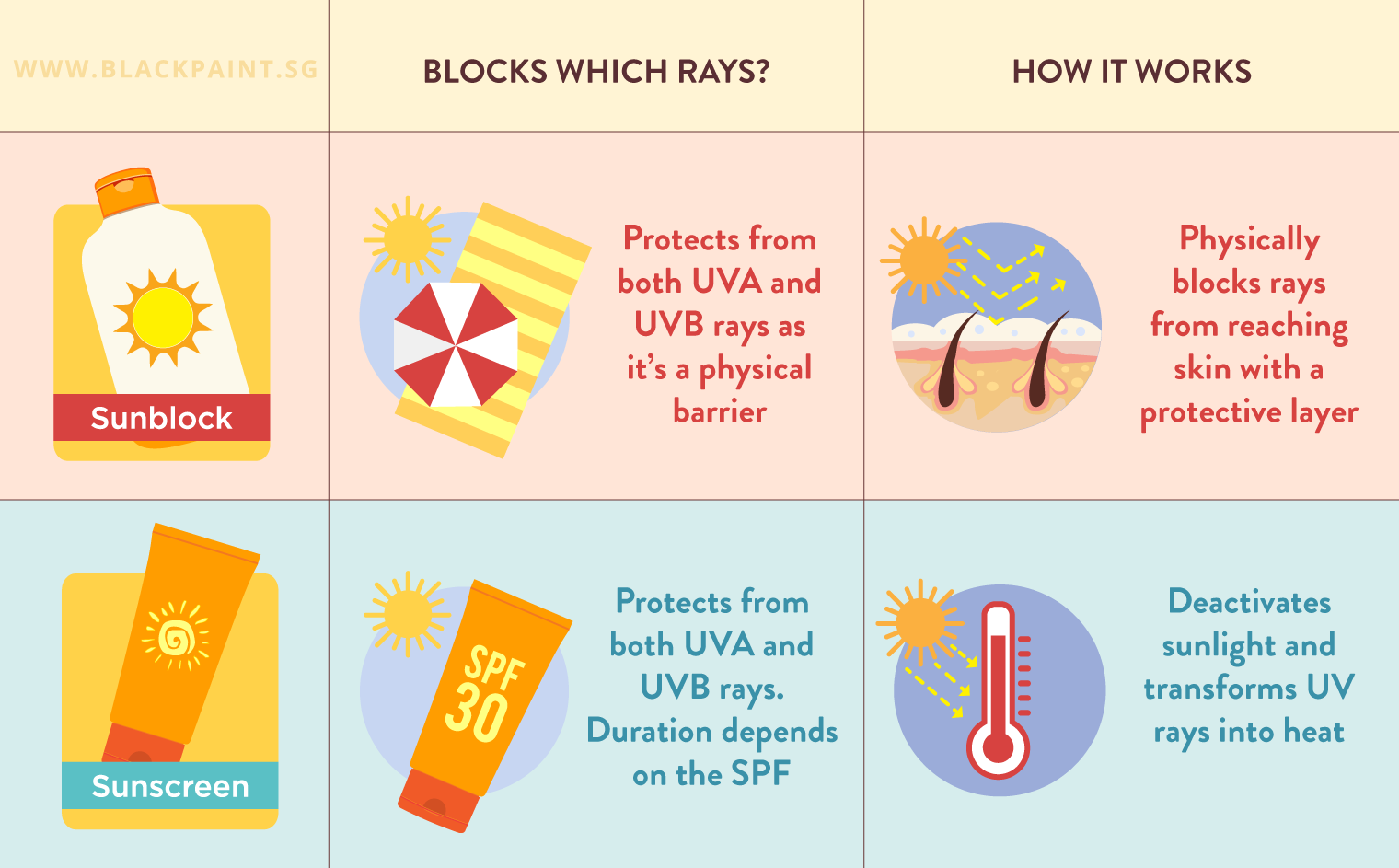
What is SPF?
SPF is the “Sun Protection Factor” and was introduced in 1974. It measures the fraction of UVB rays reaching your skin that produce sunburn. For instance, a sunblock with “SPF 15” implies that 1/15 of sunburn-causing radiation will be reaching your skin if you apply the sunblock evenly and form a thick layer at a dose of 2 mg/cm2 (milligrams per square centimeter) on your skin.
As a user, you can find out the effectiveness of a particular sunscreen/sunblock by multiplying the value of SPF by the time it takes you to get a sunburn without applying a sunblock. Hence, if you take 10 minutes to develop sunburn when you have not applied a sunblock, you will develop sunburn of same severity in 150 minutes while the intensity of the sunlight is similar and you have applied a sunblock with SPF 15.
You should take careful consideration when using SPF as a measure for UVB protection, as it does not have a linear relation to the amount of UVB that is blocked.
Sun protection factor (SPF) scale:
- A sunblock with SPF 15 is able to block 93% of UVB rays
- One with SPF 30 is able to block 97% of UVB rays
- Sunblock with SPF 50 is able to block 98% of UVB rays
There are other limitations to SPF as well. SPF does not consider a sunblock’s stability, how long will it stay on the skin, whether it is water resistant or not etc. The major disadvantage of SPF is its inability to consider UVA rays, which are the main contributor to premature aging and certain types of skin cancers.
What are broad spectrum SPF sunblocks?
Broad spectrum SPF sunblocks are those that provide protection to the skin from both UVB and UVA rays. Even when a sunblock has a high sun protection factor (SPF), but it is not a broad spectrum sunblock, it won’t protect you from all the harmful UV rays. The current system used by the FDA to number SPF only helps in identifying the number of protection sunblocks provide from exposure to UVB rays and not from exposure to UVA rays. It is an FDA requirement for a sunblock to go through numerous tests that prove its efficiency against all UVB and UVA rays to obtain the “broad spectrum” label.
It’s imperative to get protection from both types of UV rays as they cause damage to the skin in different ways. UVB rays cause burning, darkening and aging of the skin. They may also cause skin cancer. UVA rays are the foremost cause of premature aging of skin, wrinkles and skin cancer. UVA rays make up more than 90% of all UV rays and can penetrate glass and clouds all through the year.
Broad spectrum SPF sunblocks contain ingredients in such combinations that they help to protect from both kinds of rays. Look out for a blend of zinc oxide, octisalate, titanium dioxide and octinoxate. These ingredients in different combinations will provide both UVB and UVA protection.
How to pick the correct SPF
It was previously believed that sunblocks with an SPF of 15 provided sufficient protection from UV rays under most conditions. However, over the last several years, this thinking has changed and it is now believed that a higher sun protection factor is desirable.
If your skin is very sensitive or fair or you have a family history of skin cancer or you consume photo-sensitizing medicines, you may require a sunblock with a higher SPF.
The following SPF guide helps you to determine the appropriate SPF according to your skin type:
- Very Fair: Skin burns easily and never tans
SPF 20 to 30 - Fair: Skin burns easily and tans minimally
SPF 12 to 20 - Light: Skin burns moderately and tans gradually
SPF 8 to 12 - Medium: Skin burns minimally and tans well
SPF 4 to 8 - Dark: Skin burns rarely and tans readily
SPF 2 to 4 - Very Dark: Skin never burns and gets deep pigmentation
SPF 2 to 4
Broad spectrum
Opt for a sunblock with the label, “broad spectrum”. Products which do not fall into the category of broad-spectrum should carry a warning label that they provide protection only against sunburn and not against skin ageing or skin cancer.
The American Academy of Dermatology recommends a daily application of broad-spectrum sunblock with an SPF of 30 or greater to all areas of the body exposed to the sun. Reapplication should occur every two hours.

Water resistant
Choose a sunblock that is “water resistant.” This will maintain the level of SPF after 40 minutes of water immersion. A sunblock that is very water resistant maintains the level of SPF after 80 minutes of water immersion. If a sunblock is water resistant, it does not imply that it is waterproof. No sunblock is sweatproof or waterproof and manufacturers should not make a claim regarding that. If a sunblock’s label says it’s water resistant, it should mention the time for which it would last; whether for 80 minutes or 40 minutes while sweating or swimming. To get the best results, you should reapply sunblock every two hours. Reapply it more often if you are sweating or swimming. Sunblock tends to rub off when you dry yourself with a towel; hence, you should reapply after drying yourself.
How to properly apply sunblock for the best results
Check the product’s expiry date
According to the FDA, the sunblock should retain its power of protection for a minimum of three years from its date of manufacture. If the product has passed its date of expiration, throw it away and buy a new product. If the sunblock you have bought doesn’t show an expiry date, write the date of purchase on the label using a permanent marker. This will make sure that you know the duration for which you are using the product. Look for distinct changes in your sunblock such as separation, changes in colour or a difference in consistency. These indicate that the product has expired.
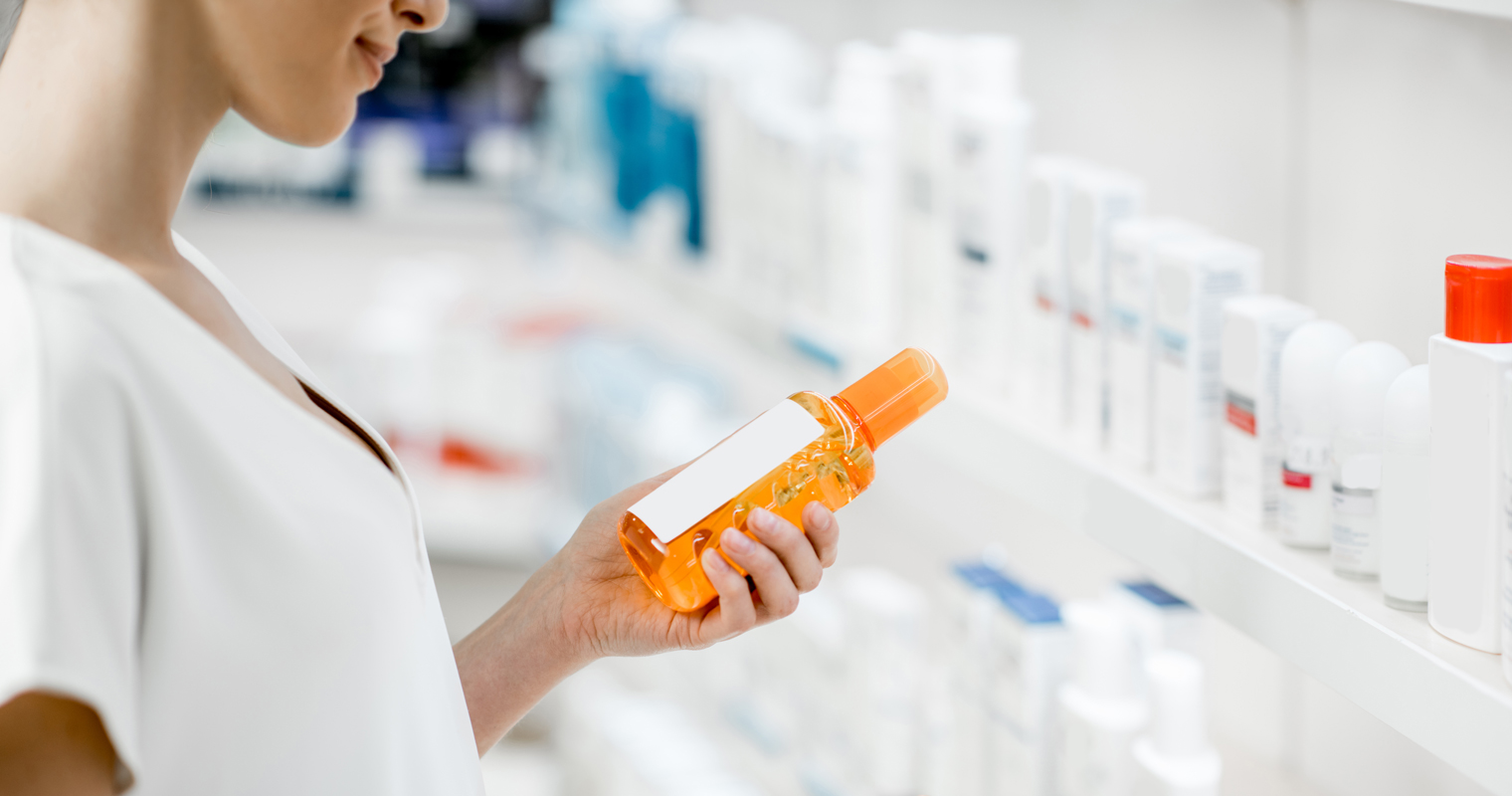
If you are using sunscreen, apply a period of time before you go outdoors
The chemical ingredients present in the sunscreen take some time to stick to the skin and provide full protection. Apply sunscreen before leaving your house. You should apply sunscreen to your body at least half an hour before stepping out into the sun, and at least 45 to 60 minutes for your lips.
Since the majority of sunscreens are removed easily from your skin, reapply them every one to two hours for optimum sun protection. You should also reapply immediately after heavy perspiration and after toweling off from swimming. You should also reapply lip sunscreens a minimum of once every hour when exposed to the sun.
Use enough
Make sure that you are getting full protection from a sunblock. Apply about one ounce, which is around a full shot glass (1.25–1.5 US fl oz or 37–44 ml). According to studies, the majority of individuals apply less than half of this amount. This implies that there is less SPF present on their bodies than advertised. If you are spending long hours at the beach, you should use about a quarter to a half of an eight-ounce bottle of sunblock. To get maximum protection from the sun’s rays, apply sunblock thickly and uniformly to all exposed skin (including your lips using lip balm or lip sunblock).
Apply sunblock to each exposed area
Don’t forget areas such as your neck, ears, and the tops of the hands and feet. It may be difficult to cover certain areas fully such as the back, so ask someone to help. Thin clothing does not provide much protection from the sun. For instance, the SPF of a white T-shirt is just 7. Wear clothes that block the sun’s UV rays or apply sunblock beneath your clothes.
Remember to apply sunblock to your face
Your face requires more sunblock in comparison to other areas of your body. Sunblock may be present in some lotions or cosmetics. However, if you are remaining in the sun for longer than twenty minutes, you should apply a sunblock on your face too. Don’t use a spray sunblock directly on your face, instead spray it onto your hands and then apply to the face. If your hair is thin or if you’re bald, apply a sunblock to your head too or wear a hat while in the sun.
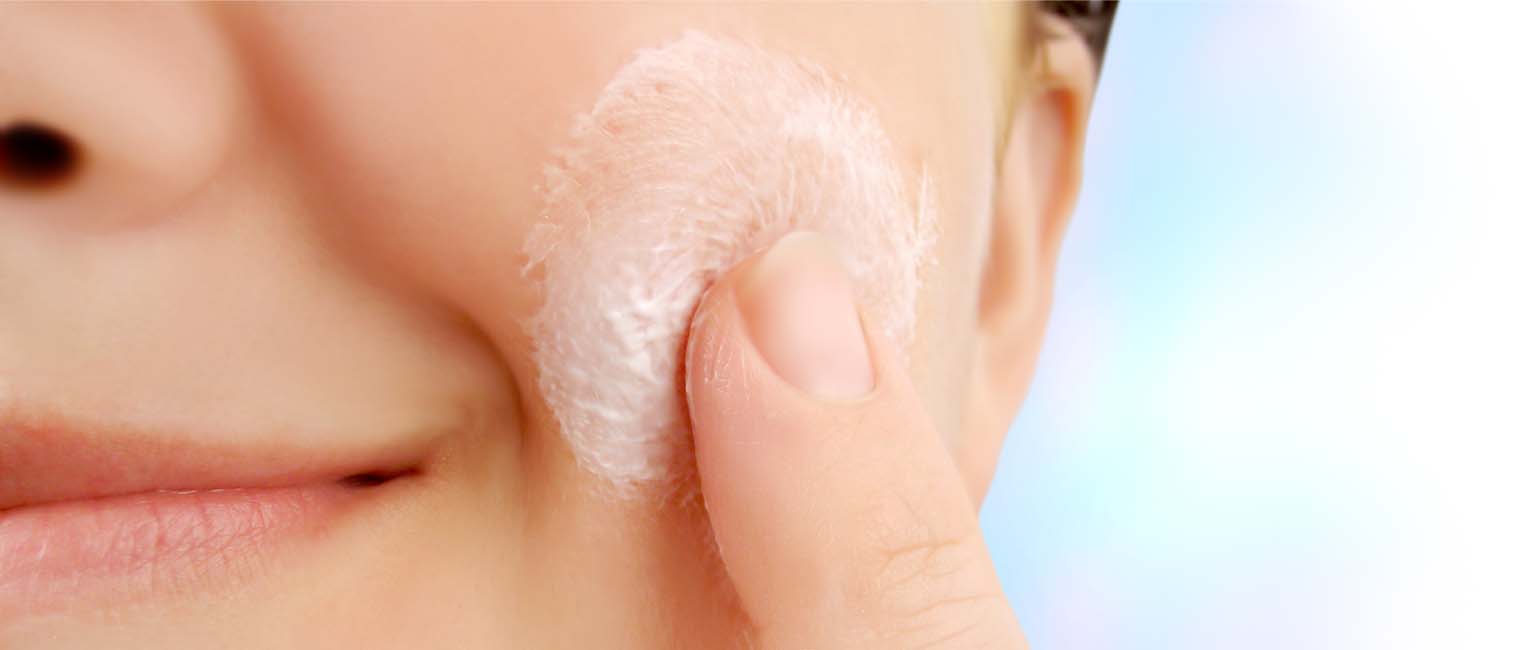
Reapply the sunblock after around 15 to 30 minutes
According to a study published in the Journal of the American Academy of Dermatology in 2001, reapplying the sunblock after around 15-30 minutes of going out in the sun is more beneficial than waiting for two hours.
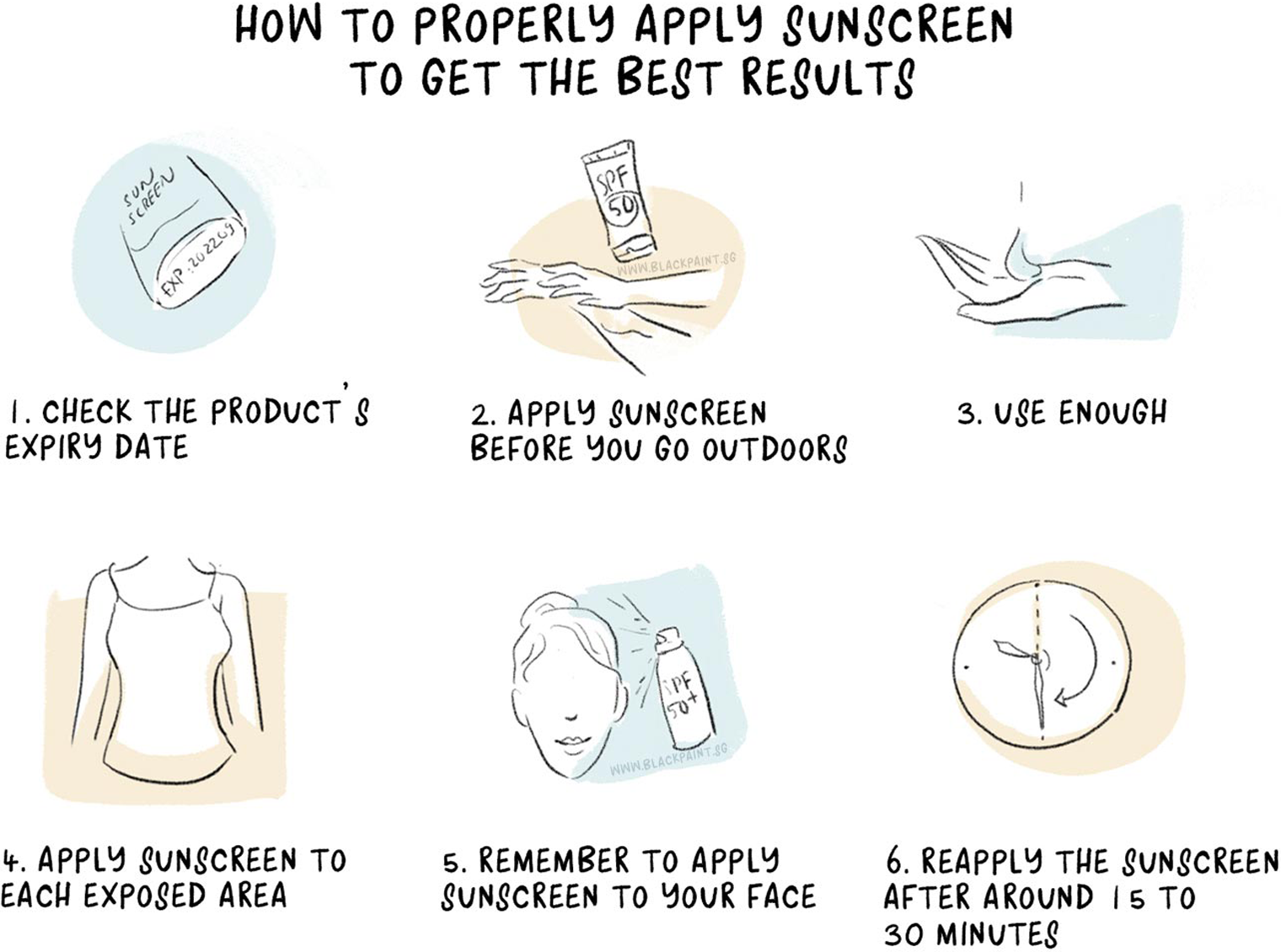
Is a high SPF value always better?
You may think that a sunblock with SPF 100 will provide tons more protection than a product with SPF 30 or SPF 50. However, the actual difference between these products is much smaller. According to the American Cancer Society, an SPF 30 product is able to block 97% of UVB, an SPF 50 product is able to block 98% and an SPF 100 product is able to block 99%.
High SPF sunblocks may backfire
One major problem while using a high SPF sunblock is that it may backfire and result in more exposure to UV rays. These products may give you a false sense of security. People using such sunblocks tend to remain in the sun much longer than usual. They often skip reapplying sunblock, and they may not seek shade, cover themselves with clothes or wear a hat. In the end, they get a lot of exposure to UV rays, which ultimately defeat the whole purpose.
To reiterate, according to the recommendations of the American Academy of Dermatology, all types of sunblock should be reapplied after every 2 hours, or after sweating or swimming. It’s also important to apply the correct amount before you go out.
It’s ideal to buy a broad spectrum sunblock with an SPF of at least 30. Moreover, do not rely only on sunblocks for sun protection. Use other methods of sun protection too such as hats, sunglasses, clothes and shade.
What is PA?
Persistent Pigment Darkening (PPD) is an emerging standard for UVA protection, and it is commonly used in Europe and Asia. PPD works in a way quite similar to how SPF works, the only difference being that it also works for UVA rays. A panel of individuals exposed to UVA rays were tested for PPD. These people were analyzed for the time their skin took to tan, and the researchers compared the results between the protected and unprotected skin. Hence, if you apply a product with PPD 10, it implies that your skin takes about 10 times longer to tan than if it was not protected.
Another standard used to measure UVA protection is PA. PA is the acronym for “protection grade of UVA.” Used in Asian countries such as South Korea and Japan, it groups and simplifies the ratings received from the PPD test.
What is the meaning of “+” behind PA?
The PA rating starts from PA+ and goes up to PA++++.
- PA+ is a sunscreen that has a PPD of two to four
(This implies that you will have two to four times less darkening of your skin and hence less skin damage from UVA when in the sun.) - PA++ is a sunscreen that has a PPD of four to eight
(This implies that you will have four to eight times less darkening of your skin and hence less skin damage from UVA when in the sun.) - PA+++ is a sunscreen that has a PPD of eight to 16
(This implies that you will have eight to 16 times less darkening of your skin and hence less skin damage from UVA when in the sun.) - PA++++ is a sunscreen that has a PPD of 16 or more
(This implies that you will have 16 times less darkening of your skin and hence less skin damage from UVA when in the sun.)
How to select the correct PA value and buy the correct product
You should opt for a sunscreen with a minimum of PA++ for protection from UVA rays.
How to properly apply PA sunscreen to make the best use of it
The tips to properly apply a sunscreen remain the same as in the previous section.
Is the more “+”, the better?
Yes, the greater the number of “+” present the better, as it increases the amount of protection provided by the sunscreen product against UVA rays.
Ingredients present in chemical sunscreens and their dangers
The various ingredients present in chemical and synthetic sunscreens and their potential effects are described below.

Oxybenzone (Benzophenone-3)
Oxybenzone, also referred to as BP-3 or benzophenone-3, is a compound that is present in many sunscreens as it absorbs UVA and UVB rays. You may find oxybenzone in many sunscreen products available today, including lotion sunscreen and foundations with SPF. It readily dissolves in creams and lotions so you get a fine product which disappears easily on your skin and provides protection from the sun’s harmful rays.
Harmful effects of oxybenzone
A study conducted by the CDC (Centers for Disease Control and Prevention) has found that there is widespread exposure of humans to this chemical. According to certain laboratory studies, BP-3 penetrates your skin and increases the synthesis of free radicals that damage DNA on exposure to light. This suggests that it has the potential to produce skin changes that may cause skin cancer. Animal studies also showed that oxybenzone or BP-3 may disrupt hormones in the body as it has weak activity similar to the hormone estrogen and moderate anti-androgen activity.
The EWG (Environmental Working Group) has given oxybenzone a hazard rating of 8 (out of 10). It also states that BP-3 has high potential to cause skin allergies.
Octinoxate (Octyl-methoxycinnamate)
This is among the most popular sunscreen ingredients as it causes less irritation than other ingredients. It is a clear liquid and is not soluble in water. It absorbs UVB rays and the FDA permits octinoxate in skin care products at 7.5%.
Harmful effects of octinoxate
When exposed to the sun’s rays, octinoxate is converted to a form that absorbs fewer UV rays compromising its effectiveness. According to a 2005 study, exposure of octinoxate to UV rays reduced its effectiveness against UV rays. This chemical also increases the production of free radicals on UV exposure because it acts as a photosensitizer, thereby damaging the skin. Moreover, this damage continues even after your skin is away from the sun’s rays. In an animal study conducted in 2004, the chemical showed a reaction similar to the hormone estrogen. The EWG gave this chemical a hazard score of 6, and also notes that it is present in mothers’ milk. Human exposure to this chemical is widespread.
Oxybenzone and octinoxate used in sunscreen in beaches result in coral damages. This leads to Hawaii’s ban on sale or distribution of over-the-counter sunscreens containing them.
Homosalate
This is a compound made from 3, 3, 5-trimethylcyclohexanol and salicylic acid. It absorbs UV rays and protects your skin from their harmful effects, especially damage to DNA that may increase your risk of developing skin cancer.
Harmful effects of homosalate
It has a similar activity to the hormone estrogen. In studies where researchers expose breast cancer cells to this chemical, they multiplied and grew 3.5 times greater than normal. In animal studies, this chemical may increase the quantity of pesticides that are absorbed via the skin. Mice that had a sunscreen applied that contained homosalate and an insect repellant DEET demonstrated a greater absorption of the insect repellent in comparison to mice that did not have sunscreen applied. Giving this chemical a hazard scoring of 4, the EWG also notes that the chemical disrupts the activity of androgen, progesterone and estrogen.
Octocrylene
This is a colourless, oily liquid made with a combination of 2-ethylhexanol and diphenylcyanoacrylate. It has the ability to absorb UVB rays along with short wavelength UVA rays. Together with a moisturizing effect, it combines easily with avobenzone and is quite often present in sunscreens along with this chemical. It enhances the stability factor of avobenzone. Octocrylene easily mixes with certain other oils so formulators use it to help with keeping the ingredients thoroughly combined in the products.
Harmful effects of octocrylene
Just like octinoxate, octocrylene acts as a photosensitizer, increasing the free radical production in the skin on sun exposure. Free radicals result in skin damage, increasing your risk of skin cancer and premature aging. According to a 2006 study, oxybenzone and octocrylene applied to the skin and left for one hour caused a spike in free radicals in comparison to that produced by the unprotected skin exposed to UV rays. The EWG gave this chemical a hazard score of 3. Human exposure to this chemical is widespread.
Octisalate
This chemical is quite similar to the chemical homosalate, also called2-ethylhexyl salicylate or octyl salicylate. It absorbs UV rays and has emollient properties which make products water resistant.
It is considered a weak sunscreen as it is not capable of protecting from UVA rays which is why it is not used alone. Rather, it is used in combination with other chemicals such as avobenzene. Octisalate degrades quickly on exposure to sunlight. It is also called a “penetration enhancer”, as it increases the amount of other chemicals that may pass into the skin. This means that if the product contains other potentially harmful ingredients such as fragrances or preservatives, it will help them to penetrate through the skin and into the body. The EWG has given this chemical a hazard scoring of 3 and notes that human exposure to this chemical is widespread.

Avobenzone
Consider avobenzone the safest among all chemical sunscreen ingredients. However, it is unstable as it may disintegrate into several unknown chemicals after topical application. It is also a broad spectrum sunscreen that is effective in absorbing UV rays over a wide range of wavelengths. Since, it can provide protection against both UVB and UVA rays, it is present in many sunscreens. The EWG has given it a low hazard scoring of 2. It does not cause hormone disruption.
Harmful effects of avobenzone
Avobenzone is an unstable chemical and it degrades on exposure to UV rays. This compromises its sun protection ability. According to one study, after two hours of exposure to sunlight, the chemical loses 85% of its ability to absorb UV rays. A study conducted in 2009 found that this chemical can cause damage to the key building blocks of skin such as tryptophan, tyrosine and thymidine. According to other research, it may produce harmful free radicals that result in protein and DNA damage. Moreover, avobenzone is among the most common sunscreen ingredients to cause contact dermatitis and allergic reactions.
Retinyl palmitate
Similar to Vitamin A, retinyl palmitate also acts as an antioxidant. It complements other ingredients in sunscreen products to protect from the harmful effects of UV rays such as premature aging. However, retinyl palmitate, which is a result of combining palmitic acid and retinol, is also a cause for concern. Upon exposure to UV rays, retinol compounds degrade and form free radicals, which damage the DNA of cells and may result in skin cancer. According to FDA studies, retinyl palmitate can actually speed up the development of skin tumours and malignant cells when it is applied to the skin before sun exposure.
Benefits of using physical sunblocks instead of chemical sunscreen
Physical sunblocks use zinc oxide and titanium dioxide to reflect UV light. These mineral sunblocks sit on the skin’s surface. They absorb and reflect sunlight so that the harmful UV rays are not able to penetrate the epidermis. The ingredients present in physical sunblocks act in a similar manner to a mirror or aluminium foil, preventing the sun’s rays from penetrating into the deeper skin layers. Sunblocks containing titanium dioxide and zinc oxide fall into the category of natural or physical sunblocks.
Dermatologists recommend using physical sunblocks instead of chemical sunscreens for various reasons. The numerous benefits of a natural physical sunblock compared to a chemical sunscreen include:
- Starts protecting from harmful UV rays immediately after application, whereas a chemical sunscreen takes about 20 minutes before it starts working
- Lasts for longer when you are exposed directly to UV rays, whereas a chemical sunscreen lasts for a shorter duration and needs frequent reapplication
- Gentler on your skin with fewer chances of clogging the pores. Better for sensitive skin. Chemical sunscreens are harsher on the skin.
No matter your skin type, your age or whether you have any particular skin problem, a natural sunblock is always a better choice. Dermatologists recommend it.
Titanium dioxide and zinc oxide
Titanium dioxide and zinc oxide are the only physical sunblock ingredients that are FDA-approved.
Benefits of zinc oxide sunblock
- A reflective material derived from the mineral zinc. Reflects the sun’s harmful rays.
- Almost invisible to the naked eye. Zinc oxide is scaled down to very tiny nanoparticles. This prevents a white and chalky look. The small particles of zinc oxide in the sunblock give the skin a slight opaque layer making it ideal for people who have a lighter skin tone and who want some coverage.
- Works as an antimicrobial, helping wounds heal quickly.
- Non-comedogenic. Free of oil and it will not clog your skin’s pores.
Zinc oxide for lightening dark spots
Zinc oxide prevents dark spots from becoming darker by protecting the skin from the sun’s harmful UV rays. Zinc oxide is among the most effective natural sunblock ingredients available as it blocks all UVB rays and both, long and short UVA rays. Blocking UV radiation prevents the body from producing melanin which is responsible for dark spots. Over a period of time, reduced melanin regeneration causes the existing dark spots to lighten.
Zinc oxide for skin whitening
By reflecting UV radiation, zinc oxide protects the skin from tanning and darkening. Reduced exposure means melanin does not regenerate and this makes the skin lighter over time. However, zinc oxide does not work like whitening chemicals that reduce the existing melanin in the skin and depigment it. It simply protects the skin from melanin regeneration and excess production caused by sun exposure.
Benefits of titanium dioxide sunblock
- Derived from the mineral titanium. Used in sunblocks and other cosmetics to thicken, lubricate, and whiten and to provide protection from UV rays.
- Almost invisible to the naked eye. Titanium dioxide is also scaled down to very small particles. This makes them less noticeable on your skin. People who have a darker skin tone can use sunblock containing titanium dioxide as it does not leave an opaque layer on the skin.
- Non-comedogenic
- Gentle on the skin and suitable for those with sensitive skin.
- Very effective at blocking UVB rays and shortwave UVA rays. Not as effective against long wavelength UVA rays.
BLACK PAINT’s Water UV Cream contains both Zinc Oxide and Titanium Dioxide. Being a physical sunblock, it is the best product to protect you against UV. It also contains plant oils and other ingredients to moisturize your skin to relieve response of the skin to sun’s damage.
What is skin whitening?
Skin whitening involves using physical treatments, substances or mixtures to lighten the colour of your skin. Other terms of skin whitening include skin lightening, depigmentation, bleaching or brightening. Treatments for skin whitening work by decreasing the skin’s melanin content. Some agents are beneficial to the skin, such as antioxidants or natural or organic agents. Other agents pose significant health risks such as methods that use mercury and other chemical agents.
How do skin whitening treatments work?
These treatments decrease the amount of melanin in the skin. Several possible mechanisms include:
- Inhibiting the activity of the enzyme tyrosinase
- Inhibiting the activation or expression of the enzyme tyrosinase: The skin lightening or whitening agent either inhibits the generation of tyrosinase or the activation of tyrosinase to its functional form.
- Destroying the intermediate chemicals produced during melanin synthesis.
- Preventing the transfer of melanin-containing melanosomes to the skin cells keratinocytes.
- Directly destroying melanin present in the cells.
- Destroying melanocytes.
Certain whitening creams may also increase the turnover of skin cells. The pigment melanin is often stored in the older cells present in deeper layers of the skin. Certain whitening creams remove these older cells. They increase the rate of cell division of skin cells. As a result, older layers of skin cells are replaced by newer layers of skin cells. These newer cells have less melanin and hence, your skin appears less pigmented and fairer than before.
Skin whitening treatments also reduce oxidative stress, which occurs with the buildup of toxins in the body. Besides compromising the overall health of a person, oxidative stress also targets melanocytes in the skin, triggering the synthesis of melanin in the cells of your skin (melanocytes) and causing skin darkening. Many creams contain potent antioxidants, which reduces the oxidative stress from your body and the content of melanin.
Various types of skin whitening treatments
Retinoids
Retinoids including tretinoin, tazarotene, isotretinoin and adapalene are functional and structural equivalents of vitamin A. They are used as a common skin whitening option for treating hyperpigmentation resulting from inflammation and photo-damage. Retinoids also play the role of performance enhancers while they are utilized with other skin lightening agents like mequinol and hydroquinone.
Mechanism of action
They likely inhibit the induction of tyrosinase and interfere with the transfer of pigment melanin. They also modulate cellular proliferation and accelerate cell turnover of the epidermis. Though monotherapy with tretinoin for hyperpigmentation is effective; however, it is a slow therapy and usually needs a minimum of 24 weeks for visible improvement.
Hydroquinone
Hydroquinone, also known as quinol or benzene-1, 4-diol is an organic compound that exists in white, solid and granular form. It is found naturally in various plants and in wheat, tea, beer, coffee, berries and wine, but breaks down in your liver into inert ingredients. Hydroquinone effectively inhibits melanin production both in vivo and in vitro. It is quite frequently utilized as a topical skin whitening agent to treat skin pigmentation. It is a common ingredient in OTC skin whitening products.
Mechanism of action
It inhibits the enzyme tyrosinase; thereby, blocking the conversion of DOPA (dihydroxyphenylalanine) to melanin. HQ has structural similarity to melanin precursors and this enables its interaction with the enzyme tyrosinase. Additionally, HQ also inhibits synthesis of RNA and DNA and is selectively cytotoxic towards melanocytes; thereby, causing their destruction. Improvement with hydroquinone therapy usually appears after four to six weeks of treatment.
Kojic acid
It is a fungus metabolite derived from several fungi such as Aspergillus, Penicillin, and Acetobacter. It is related chemically to hydroquinone.
Mechanism of action
It acts by inhibiting the activity of enzyme tyrosinase. It has antioxidant properties and scavenges free radicals. Kojic acid reduces the melanin content of the melanocytes.

Mequinol
It is an alternative to the compound hydroquinone and similar to the later it has a cytotoxic effect on melanocytes.
Mechanism of action
The enzyme tyrosinase oxidizes mequinol to produce quinones which are cytotoxic to melanocytes. Their formation results in the destruction of melanocytes and depigmentation of the skin. Though mequinol and hydroquinone are related, it is thought that mequinol irritates your skin less as compared to hydroquinone.
Niacinamide
It is the biologically active form of vitamin B3 (niacin) that is present in various yeasts and root vegetables. It is an important precursor to co-factors nicotinamide adenine dinucleotide phosphate (NADPH) and nicotinamide adenine dinucleotide (NADH). Niacinamide is very stable and is usually unaffected by moisture, acids, light, oxidizers and alkalis. It is a common ingredient in OTC skin lightening products.
Mechanisms of action
It reduces the transfer of melanin-containing melanosomes from melanocytes to keratinocytes. Retinyl palmitate along with niacinamide reduce hyperpigmentation and produce skin whitening after four weeks of treatment.
Vitamin C
Ascorbic acid or vitamin C is a naturally occurring vitamin that is water soluble and is present in leafy green vegetables and citrus fruits. It has antioxidant properties. In the form of injection, it inhibits the tyrosinase enzyme, which helps in the process of whitening of the skin.
Mechanisms of action
It inhibits the activity of enzyme tyrosinase and reduces DOPAquinone, a precursor to the pigment melanin. It also acts as an antioxidant and scavenges free radicals.

Liquorice
Liquorice extract obtained from the roots of Glycyrrhiza uralensis or Glycyrrhiza glabra is an ingredient that is commonly present in many cosmetics (available as OTC creams) used for skin whitening. The primary anti-inflammatory and antioxidant compounds present in liquorice extract are glycosides: glycyrrhizic acid and glycyrrhizin, saponins and flavonoids.
Mechanisms of action
The major component of liquorice root is glabridin. It inhibits the activity of enzyme tyrosinase and prevents UVB-induced pigmentation. According to various studies, it whitens the skin more efficiently than hydroquinone.
Glycolic acid
It is an acid derived from sugar cane. It has two types of skin whitening effects. At lower concentrations, it results in quick desquamation of melanin-containing keratinocytes. It shortens the cycle of a cell so that melanin pigment is lost quickly. At high concentrations, it causes epidermolysis. In several studies, superficial epidermal layers are removed with chemical peels of glycolic acid at concentrations of 30-70%. It enhances the penetration of several other topical skin whitening agents including hydroquinone.
Corticosteroids
Many skin whitening creams may contain corticosteroids in high doses. Although they are useful to treat inflammatory conditions of the skin such as dermatitis, psoriasis or eczema, their use for skin lightening is controversial. However, they whiten the skin very fast as they constrict the blood vessels of the treated region, slowing the blood flow and giving your skin a fairer appearance. Steroids may also slow down the cell regeneration process; hence producing fewer melanocytes in the skin resulting in a decline in melanin production.
Chemical peel
Chemical peel acids at strong concentrations treat the desired skin area. They reduce hyperpigmentation of skin by removing the epidermal skin layer. Deeper versions of chemical peel are also available that penetrate the dermis (middle layer of skin) and produce more visible results.
Although you may get many types of chemical peels over-the-counter; but you should consider talking to a dermatologist and get a professional chemical peel. These peels are more powerful than OTC peels and also provide results quickly. Chemical peels work well for age spots, blotchy skin, melasma and sun damaged skin.
Laser peel
In a laser peel or skin resurfacing treatment, light beams are targeted at hyperpigmentation areas of the skin. There are 2 kinds of laser treatment: non-ablative and ablative. An ablative laser is more intense and it involves removing skin layers. In non-ablative laser treatment, it targets the dermis to promote the growth of collagen and produce tightening effects.

IPL (Intense Pulse Light therapy)
This is a kind of fractional of non-ablative laser treatment or a “photo facial”. It stimulates the growth of collagen in the dermis. It targets overall pigmentation issues; however, flat spots particularly respond to IPL. You may generally need multiple sessions of IPL to see the results.
Microdermabrasion
This is a procedure that treats dark skin or hyperpigmentation affecting only the epidermis. During this procedure, the dermatologist uses a handheld device that resembles a drill machine and that has a wire brush attachment. The dermatologist rapidly and gently swipes the tool across the skin and removes the epidermis. You might require multiple sessions to achieve the desired results.
Dermabrasion
Dermabrasion also involves the removal of the epidermis; however, the effect of dermabrasion continues to some portion of the dermis. Dermabrasion addresses dark skin related to ageing and sun damage. During this procedure, the dermatologist also uses a handheld device resembling a drill machine with an abrasive attachment. Moving the tool rapidly and gently across the skin, this removes the entire epidermis and the top portion of the dermis. Try dermabrasion if you want to reduce pigmentation at a rate faster than microdermabrasion.

Ingredients present in synthetic whitening products and their disadvantages
Skin whitening products contain ingredients which act by slowing the melanin production in the epidermal layer of the skin. Skin whiteners based on chemicals can be dangerous. They carry a significant health risk when used for extended periods of time.
Chemicals used in synthetic skin whitening products may include mercury, hydroquinone and steroids. While some countries have banned their use, some healthcare professionals still do prescribe a few of these ingredients. The major danger of exposing your body to these toxic chemical ingredients is that they gradually produce harmful side effects and health issues. These include skin discolouration, malfunction of internal organs such as kidneys and an increased risk of skin cancer.
Hydroquinone
The manufacturing of rubber involves using this toxic chemical, as well as in the processing of black and white films and in certain hair dyes. It is present in skin whitening products as it is a successful bleaching agent. It reduces the activity of the enzyme tyrosinase that helps in melanin production.
Hydroquinone is deemed cytotoxic, carcinogenic and mutagenic. Researchers believe that it increases the risk of liver disease, adrenal dysfunction and thyroid disorders. It is banned as a skin whitener in countries such as Japan, Australia and Europe. The FDA (Food and Drug Administration) proposed banning hydroquinone in the USA in 2006. Currently, though, products for skin whitening containing 2% of the chemical is still sold as an OTC product. Products which have up to 4% of the chemical are prescribed by a physician.
Common adverse effects of hydroquinone creams are skin rashes, skin irritation, burning, cracking or dryness of the skin and excessive redness. Prolonged usage of hydroquinone produces a condition referred to as ochronosis, characterized by the darkening of the areas. The skin darkening is progressive and is irreversible. Like other skin whitening chemicals, hydroquinone may make the skin more prone to UV damage. This may result in serious sunburn and may also increase your risk of developing certain skin cancers.

Mercury
The FDA issued a consumer warning in 2013 advising them not to use creams, lotions or soaps containing mercury as they may result in mercury poisoning. The FDA banned the use of mercury in products for skin whitening and skin bleaching in 1990. Mercury is a toxic chemical which the body absorbs readily, but is quite difficult to excrete. When mercury is used for skin whitening, this produces initial adverse effects including discolouration, scarring and rashes. Long-term exposure may have more dangerous consequences for health.
According to the WHO, using mercury for a long duration may damage the nervous system and kidneys. It may also result in psychosis or depression. Mercury can also interfere with fetal brain development if used by pregnant females.
According to a recommendation by the FDA, always read the labels of all skin whitening products you use. Those that contain mercury will list it as mercury, mercuric, mercurio, calomel or mercurous chloride. If the product does not have a list of ingredients or there is no label on the product, it is better to not use it.
Steroids
Unfortunately, many creams used for skin whitening may contain illegal ingredients that can include steroids in high doses. Although steroids are useful for treating skin inflammation, they should not be used for skin whitening.
Steroids are usually available through a dermatologist-issued prescription, and their use is limited to a short period. Topical corticosteroids may produce the appearance of skin lightening very fast due to their vaso-constrictive action.
Steroids may also slow down the cellular regeneration process, reducing melanocyte formation and resulting in a decline in melanin production. The negative side effect of slowing this natural cell renewal process is that the epidermis may become thinner. This may lead to veins being visible through the skin (photo).
Using steroids in high doses without a physician’s supervision may result in many problems. Skin thinning due to long-term topical use of steroids may increase the risk of physical injury to the skin. The skin may become more prone to environmental and chemical damage due. Moreover, this increases the risk of damage from the sun’s rays. There may be additional pigmentation problems.
Many illegal whitening creams contain steroids in high doses. These may disrupt the body’s hormone levels. In extreme cases, this may lead to disorders like Cushing’s syndrome in which the adrenal glands are affected.
Ingredients commonly used in natural and organic whitening products and their mechanisms
There is an increased awareness of the dangers of skin whitening products, and more products now contain organic ingredients. These are largely free of side effects. Some of the ingredients commonly used in natural and organic skin whitening products are described below:
Arbutin
This is a natural compound obtained from the dried leaves of the blueberry plant. It is also naturally present in cranberries, bearberries, pears, California buckeye and wheat. It is a naturally occurring derivative of hydroquinone. The use of arbutin is less irritating compared to using concentrated hydroquinone. Arbutin is present in whitening cream used for underarms. According to research, it inhibits melanin synthesis by inhibiting the activity of enzyme tyrosinase. It also inhibits the maturation of melanosomes. Research demonstrates that the efficiency of arbutin is 10 times more than ordinary chemicals used in skin whitening creams. However, unlike chemical ingredients arbutin’s toxicity is minimal and as a result, it produces very minor adverse effects.
Niacinamide
Vitamin B3 or niacin in its active form is also called niacinamide. A deficiency of niacin may result in hyperpigmentation of the skin. Conversely, using products containing niacinamide may result in significant skin whitening. Niacinamide acts by blocking the transfer of melanosomes to keratinocytes. According to a Japanese study published in the British Journal of Dermatology, niacinamide is very effective in reducing hyperpigmentation and increasing skin lightness after four weeks of use. Moreover, there are no adverse effects of using the compound.
Kojic acid
Research says that this natural ingredient used in skin whitening products works in a manner similar to the chemical hydroquinone. Moreover, its efficiency is similar to that of hydroquinone. Most importantly, the results produced by kojic acid last longer than those produced by hydroquinone.
Vitamin C
Almost every cosmetic and skincare products contain vitamin C. This is because it is a potent antioxidant which helps in flushing out toxins from the body. It also inhibits the synthesis of melanin. Vitamin C increases skin vascularity, hydration and elasticity.
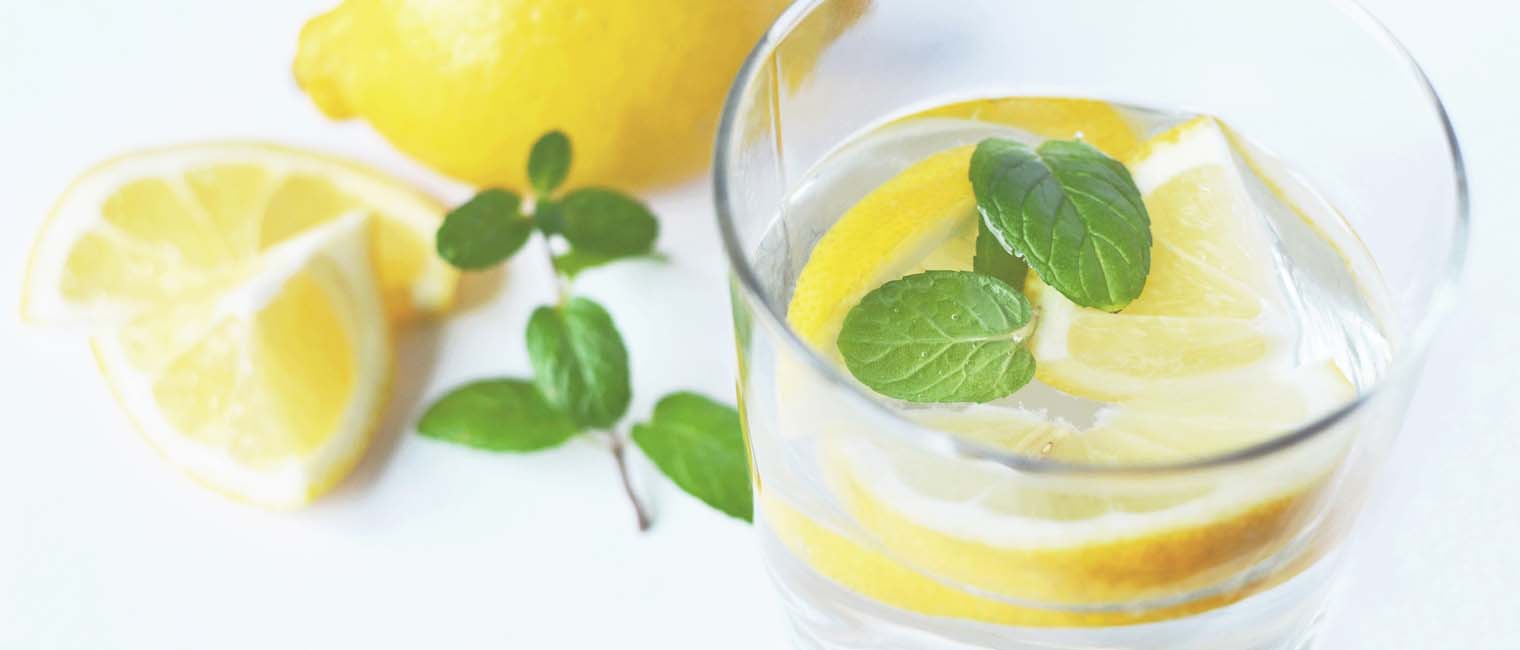
Liquorice extract
Liquorice extract is obtained from the root of Glycyrrhiza uralensis or Glycyrrhiza glabra. It is present in many skin whitening cosmetics.
The major component of liquorice root is glabridin. It inhibits the activity of the enzyme tyrosinase and prevents pigmentation induced by UVB rays. Various studies have also shown that Glabridin’s skin whitening efficiency is more than that of hydroquinone.
Mulberry extract
The dried leaves of the mulberry plant in 85% alcohol extract acts have inhibiting properties, suppressing the activity of the enzyme tyrosinase. The active component of the mulberry extract is mulberroside F. This has shown inhibitory effects on the activity of tyrosinase and also on the formation of melanin. This compound also acts as a free radical scavenger and protects from auto-oxidation.
Other natural methods to prevent skin darkening
Your skin produces melanin pigment to protect itself against exposure to UV rays. This causes it to become darker. However, skin darkening also indicates skin damage. The only method of preventing the skin from turning dark is to keep it protected from the sun’s UV rays. There are multiple ways in which you can do it apart from applying a sunblock. Some of these natural methods are:
Wear clothing designed for sun protection
Certain clothing that is certified using international standards is available. It will have information regarding its UPF (ultraviolet protection factor). If it is not practical for you to wear such clothing, try and wear at least a T-shirt. Remember that the SPF of a T-shirt is less than 15 so you should use other kinds of sun protection too. Wear long pants, skirts and shirts with long sleeves to cover your body when out in the sun. Use clothes made with tightly woven fabric as they provide the best protection. A dry T-shirt offers more protection from UV rays than a wet T-shirt. Wear dark colours instead of light colours as they provide more protection from UV rays.
Wear a hat
A wide-brimmed hat shades your ears, the back of your neck and your face. Opt for a hat made of canvas. Avoid hats made of straw, which have holes. A dark-coloured hat may provide more protection from UV rays than a light one. If you are wearing a baseball cap, pair it with a bandana to cover the exposed areas.

Stay in the shade
Seek shade under a tree, an umbrella or other types of shelter such as roofed structures. You can use an umbrella with a UV coating. It is a great idea to carry an umbrella with you regularly while you are going out as it provides protection against both rain and sun. A black coloured umbrella provides a UPF of about 50+ so whenever you are out in the sun to use your umbrella to provide shade for yourself.
Check the UV index
The UV index measures the strength of the sun’s UVB and UVA rays. A high index indicates that the sun is stronger and there are greater chances of your skin turning dark. You can find the index of your area at the WHO’s UV index webpage or at websites such as Sunburn Map. A UV index ranging from 0 to 2 is considered low (you may go without sun protection), from 3 to 7 is considered moderate (you require sun protection), 8 and higher is high (you must take extreme steps for sun protection) and 10 and higher is considered extremely high (you must remain indoors as much as possible).
Go out during certain timings
Avoid going out in the sun between 11 am and 4 pm. Try to remain indoors during these hours of the day. Try and schedule any outdoor trips and activities during early morning or evening hours. If you have to go out in the sun during the afternoon hours take adequate precautions so as to protect yourself from sun exposure. This holds special importance when the UV index ranges from moderate to high. Though sun’s rays are stronger in summers; but you still require sun protection in winters, especially if you are going skiing. This is because at higher altitude the quality of air is thinner; hence, sun’s rays are stronger and more damaging.

References
https://www.msdmanuals.com/home/skin-disorders/biology-of-the-skin/structure-and-function-of-the-skin
https://www.aad.org/public/kids/skin/what-gives-skin-its-color
https://www.myvmc.com/anatomy/skin-colour/
https://www.sciencedaily.com/releases/2008/02/080222155212.htm
https://www.epainassist.com/skin/does-skin-tone-get-darker-with-age
https://www.medicalnewstoday.com/articles/242679.php
https://www.news-medical.net/news/2007/08/07/28543.aspx
https://www.thedermreview.com/sunblock-vs-sunscreen/
https://www.verywellhealth.com/sunscreen-or-sunblock-514381
http://www.who.int/uv/faq/uvhealtfac/en/
http://www.smartskincare.com/skinprotection/sunblocking-effectiveness.html
https://www.pcaskin.com/what-is-broad-spectrum-spf
http://www.hawaiiantropic.com/sun-care-tips/faq-suncare/how-do-i-choose-the-right-sunscreen-and-spf-for-me
http://www.hawaiiantropic.com/sun-care-tips/faq-suncare/how-do-i-choose-the-right-sunscreen-and-spf-for-me
https://www.cancer.org/latest-news/choose-the-right-sunscreen.html
https://www.mayoclinic.org/drugs-supplements/sunscreen-agent-topical-application-route/proper-use/drg-20070255
https://www.skincancer.org/prevention/sun-protection/sunscreen/sunscreens-explained
https://www.ncbi.nlm.nih.gov/pubmed/11712033
https://www.thisisinsider.com/do-high-spf-sunscreens-work-better-50-2017-5
https://theklog.co/spf-meaning/
http://www.skinwhiteningscience.com/top_skin_whitening_agents_top_20_retinoids.html
http://www.skinwhiteningscience.com/melanin_synthesis_pathways.html
http://www.skinwhiteningscience.com/top_skin_whitening_agents_top_20_hydroquinone.html
http://www.skinwhiteningscience.com/top_skin_whitening_agents_top_20_kojic_acid.html
http://www.skinwhiteningscience.com/top_skin_whitening_agents_top_20_mequinol.html
http://www.skinwhiteningscience.com/top_skin_whitening_agents_top_20_niacinamide.html
http://www.skinwhiteningscience.com/top_skin_whitening_agents_top_20_vitamin_c.html
http://www.skinwhiteningscience.com/top_skin_whitening_agents_top_20_licorice.html
http://www.skinwhiteningscience.com/top_skin_whitening_agents_top_20_glycolic_acid.html
https://www.healthline.com/health/beauty-skin-care/hyperpigmentation-treatment#options-for-each-skin-tone
https://www.ewg.org/sunscreen/report/the-trouble-with-sunscreen-chemicals/#.W5pbhNIzbIU
https://www.womenshealthmag.com/beauty/a19919520/6-scary-sunscreen-ingredients-and-6-safe-spf-products/
http://www.colorescience.com/learn/zinc-oxide-titanium-dioxide
http://skinwhiteningnews.org/dangers-of-skin-whitening/
https://www.ncbi.nlm.nih.gov/pubmed/12100180
https://www.ncbi.nlm.nih.gov/pubmed/7714722
http://skinlightenerreview.com/skin-whitening-cream/
http://www.skinwhiteningscience.com/top_skin_whitening_agents_a_z_mulberry.html
https://www.cdc.gov/cancer/skin/basic_info/sun-safety.htm#clothing



 Water UV Cream
Water UV Cream




